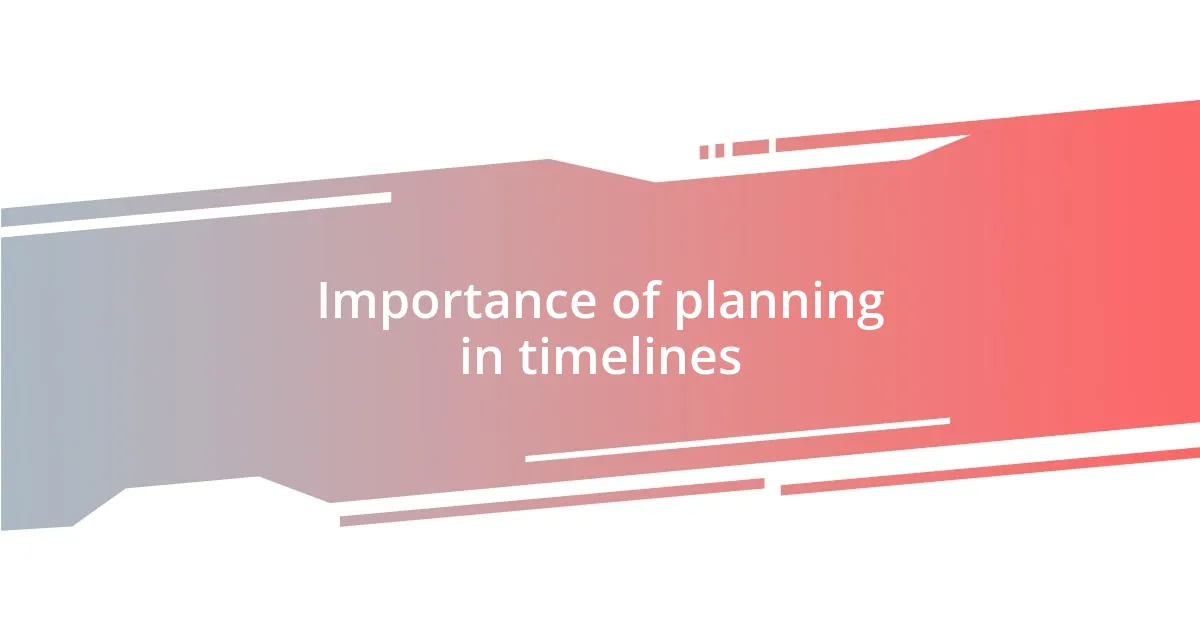Key takeaways:
- Reception timelines serve as essential roadmaps, alleviating anxiety and fostering motivation through clear, time-bound milestones.
- Effective planning enhances clarity, reduces stress, and optimizes resource allocation among team members.
- Key elements of successful timelines include clear milestones, defined roles, regular updates, and flexibility to adapt to unexpected changes.
- Utilizing digital tools and regular communication can greatly improve project management and ensure team alignment.

Understanding reception timelines
Understanding reception timelines is crucial for anyone involved in coordinating events or meetings. When I first started in event planning, I remember feeling overwhelmed by the amount of detail required. But as I learned about these timelines, I realized they serve as a roadmap, guiding every aspect of the process.
In my experience, breaking down tasks into clear, time-bound milestones alleviated much of that initial anxiety. What really stood out for me was how anticipation builds with each completed step. Have you ever noticed that when you tick off a task from your list, it creates a sense of achievement? That feeling can be profound when applied to reception timelines, as it motivates teams and keeps the energy high.
A well-organized reception timeline not only ensures nothing is overlooked but also allows for unexpected changes. One time, we had a last-minute venue shift, and having that timeline made it easier to adjust quickly. I think about how vital it is to remain flexible while still sticking to a core plan. How do you manage spontaneity when things don’t go as planned? For me, understanding that reception timelines are living documents has been an eye-opener, reinforcing my belief in the value of preparation while embracing the unpredictability of events.

Importance of planning in timelines
Planning is the backbone of successful reception timelines. From my experience, one of the most beneficial aspects of planning is the clarity it brings, not just for the planner but for everyone involved. For instance, when I planned a corporate event, having a detailed timeline allowed each team member to understand their roles and expectations. This alignment fosters a sense of ownership and accountability, making the execution smoother.
Additionally, I’ve noticed that timelines significantly reduce the stress levels in high-pressure environments. During a wedding I coordinated, the couple naturally felt anxious about the big day. However, by sharing a comprehensive timeline with them, I could see their worries dissipate. Having set milestones made everything feel manageable, leading to a joyful anticipation rather than overwhelming nerves.
Lastly, planning allows for better resource allocation. In one instance, I managed a community event where we had limited volunteers. Developing a timeline helped me prioritize tasks and assign roles effectively. This strategic use of time and resources ensured that the event ran efficiently and positively. Have you ever felt a sense of ease when everything falls into place on schedule? That’s the power of careful planning.
| Aspect | Impact of Planning |
|---|---|
| Clarity | Enhances understanding of roles and expectations |
| Stress Reduction | Alleviates anxiety through structured milestones |
| Resource Allocation | Optimizes task assignments and efficiency |

Key elements of effective timelines
Creating effective reception timelines involves several key elements that can truly transform the planning process. Based on my observations, I believe clarity and communication are critical. For example, when we organized a significant corporate event, we established a shared timeline accessible to everyone involved. This transparency not only kept the team aligned but also built trust and collaboration, turning a group of individuals into a cohesive unit.
Here are some key elements to consider for effective timelines:
- Clear Milestones: Establish specific milestones that are easy to track.
- Role Assignments: Clearly define responsibilities for each team member.
- Regular Updates: Schedule checkpoints to review progress and make necessary adjustments.
- Flexibility: Build in buffer times to account for unexpected changes.
- Visual Format: Use charts or graphs, making the timeline visually engaging.
In my experience, maintaining a sense of flexibility is crucial. I recall a particularly chaotic event where a keynote speaker canceled hours before the start. Instead of panicking, our well-structured timeline helped us pivot quickly. We divided tasks based on who was best suited to find a replacement, effectively utilizing our resources and maintaining the event’s momentum. It’s moments like these that highlight how effective timelines not only guide the process but also empower teams to adapt and overcome challenges with confidence.

Strategies for successful timeline execution
When it comes to executing a timeline successfully, I believe that constant communication is paramount. I remember a project where we faced a significant hiccup because one team member misunderstood their responsibility. If we had held more regular check-ins, this could have been avoided. It’s fascinating how a simple text or quick meeting can keep everyone on the same page and maintain momentum.
I also find it incredibly beneficial to visualize the timeline. For instance, during a particularly big community festival I organized, I created a large poster with all our key dates and tasks that we hung in our common area. It became a visual anchor for the team, sparking daily conversations about progress. Have you ever noticed how a clear visual can inspire action? It’s a game-changer in keeping everyone engaged and motivated.
Lastly, flexibility has saved me more times than I can count. Once, while managing a retreat, an unexpected storm forced us to change our location. Instead of panicking, our adaptable timeline allowed us to evaluate the situation quickly and redistribute tasks. This experience taught me that timelines should be living documents, capable of evolving with circumstances rather than being rigid. How do you handle unforeseen changes in your plans? Embracing flexibility can turn challenges into opportunities for innovation.

Tools to manage reception timelines
When managing reception timelines, I’ve found that utilizing digital project management tools can make a world of difference. For instance, I once relied on Trello for a marketing event where tasks constantly evolved. With its user-friendly interface and visual boards, I could quickly reassign tasks or track progress, which kept my team motivated and aware of their contributions. Have you ever felt overwhelmed by a project? Tools like this can transform chaos into clarity, providing a structured way to manage responsibilities.
Another tool I love is Google Calendar, especially for scheduling and reminders. During a multi-day conference, I synchronized everyone’s calendars for deadlines and key meetings, allowing us to stay aligned. Imagine how reassuring it was to receive reminders about crucial checkpoints! Knowing that everyone was on the same page created a collective sense of accountability, reducing last-minute surprises. How often do we underestimate the power of a simple reminder?
Lastly, I can’t stress enough the benefits of collaborative document platforms like Google Workspace. When planning a charity gala, every detail needed input from various stakeholders. By using shared documents, the team could contribute ideas in real-time, ensuring everyone felt valued. This not only fostered creativity but also built camaraderie. Have you experienced the thrill of collective brainstorming? It enriches the planning process and leads to truly innovative outcomes.

Common challenges in reception timelines
When it comes to reception timelines, one of the most common challenges I’ve faced is managing differing expectations among team members. I recall a time when everyone had their own idea of what the end product should look like, leading to conflicting priorities. It felt frustrating to spend hours aligning visions that could have been addressed upfront, a reminder that clear communication at the outset is crucial. How often do these misunderstandings derail your projects?
Another challenge I’ve encountered is the pressure of tight deadlines. I remember working on a large event where the timeline felt overwhelmingly ambitious. As the due dates approached, stress levels soared, affecting my team’s morale. I learned the hard way that allowing breathing room in the schedule not only enhances quality but also helps maintain a positive working environment. Have you ever felt that race against time? It’s like running a marathon without proper training; you need a sustainable pace to make it to the finish line.
Finally, resource allocation often poses a significant hurdle. In my experience, trying to juggle limited personnel and budget constraints can derail even the best-planned timelines. During a community outreach project, I once under-resourced a key phase, resulting in unnecessary delays and frustration. This taught me the importance of realistic planning—conceptualizing what’s genuinely feasible within available resources. Have you dealt with tight budgets derailing your goals? It’s all about striking the right balance between ambition and practicality to foster success.

Tips for improving timeline efficiency
To enhance timeline efficiency, I advocate for regular check-ins with the team. When I worked on a school event, weekly meetings helped us stay aligned and address potential hitches early on. Have you experienced how a simple gathering can clear misunderstandings? I found that just a few minutes to discuss our progress often led to solutions that kept us on track.
Another effective strategy is breaking tasks into smaller, actionable steps. I vividly remember a project where my team felt daunted by a massive deadline. By dividing the workload into bite-sized pieces, we turned an overwhelming task into manageable chunks. Have you ever noticed how conquering one small task can build momentum? It’s amazing how that feeling of accomplishment propels everyone forward.
Lastly, maintaining flexibility in your timelines can be a game changer. During a recent launch, we encountered unexpected challenges that required quick adjustments. Instead of panicking, we embraced the change, which led to creative solutions. How do you respond when things don’t go as planned? I believe it’s crucial to remember that agility often sparks innovation, turning potential pitfalls into opportunities.












